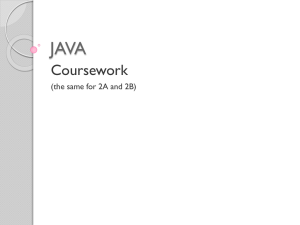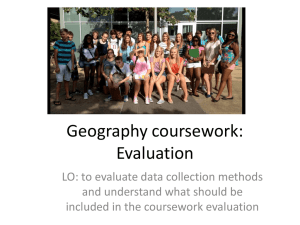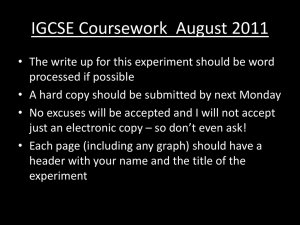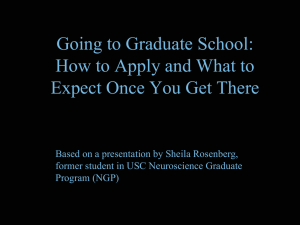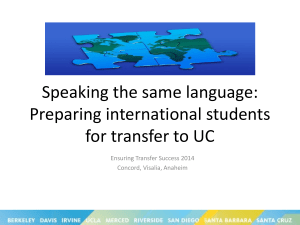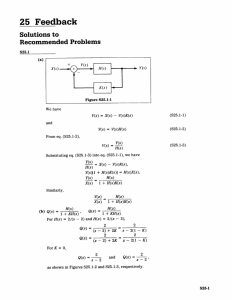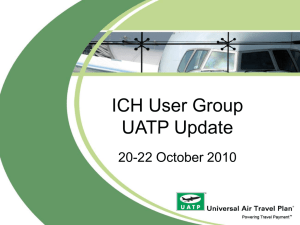Approaching Food & Nutrition Coursework
advertisement
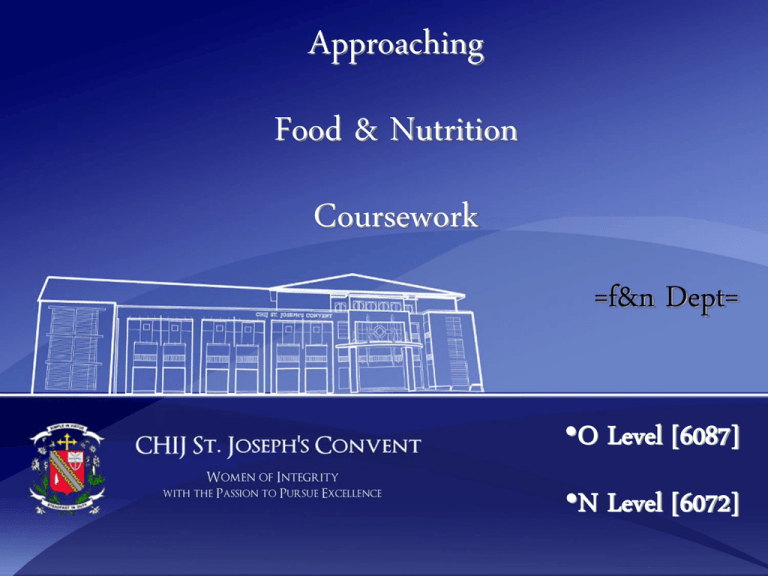
Approaching Food & Nutrition Coursework =f&n Dept= •O Level [6087] •N Level [6072] Programme Outline 1. Introduction 2. Workshop Examination Format What is Coursework? Mode of Assessment Coursework Steps & expectations Important Note [45mins] 3. Sharing Session by graduated F&N students [10mins] 4. Q & A Session [15mins] 5. Viewing of past year coursework samples [20mins] 6. End of Workshop Introduction Food & Nutrition Department Level Teacher(s) HOD F&N Mrs Maria Tan 3 Normal Academic 1. Mrs Alice Ho 2. Mrs Joanna Goh 3 Express 1. Mrs Ping Freeman 2. Mdm Dewi 4 Normal Academic 1. Mdm Dewi 4 Express 1. Mrs Ping Freeman 2. Mrs Joanna Goh 5 Normal Academic 1. Mdm Dewi 2. Mrs Joanna Goh Examination Format GCE Normal (Academic) Level Paper Paper 1 Paper 2 Assessment Written Paper Section A – Short Answer Qns [20m] Section B – Data Response Qns [28m] Section C – Open-ended/ Essay Qns [32m] Coursework [30pg Full Report Writing] Task Analysis 6m Research (gather & process information) 8m Decision Making 8m Planning 8m Execution – Practical Exam 24m Evaluation 6m Marks Duration 80 marks 1h 30mins [40%] 60 marks [60%] January ~ July *Max 10 – 12 hrs during curriculum with teacher’s facilitation only! Examination Format GCE Ordinary Level Paper Paper 1 Paper 2 Assessment Written Paper Section A – Short Answer Qns [20m] Section B – Data Response Qns [35m] Section C – Open-ended/ Essay Qns [45m] Marks Duration 100 marks 2 hours [40%] Investigative Coursework [50pg Full Report Writing] Task Analysis Research & Development 10m 34m Information Gathering - 12m Investigation - 10m Information Synthesis - 12m Decision Making Planning Execution – Practical Exam Evaluation 10m 10m 24m 12m 100 marks [60%] January ~ August *Max. 15 - 20hrs during curriculum with teacher’s facilitation only! What is Coursework? • • • • • Written or practical work done by a student during a course of study, usually assessed in order to count towards a final mark or grade Requires a problem-solving and investigative approach with an emphasis on experimental work – food investigative experiment - O Level. Candidates are to craft/ design food-based experiments/ investigation (with purpose/ aim and findings) – O Level. Assessment of coursework will focus on the candidates’ ability to: – Analyze task question in depth – Factual information gathering and summarizing facts – Develop a plan, record and interpret experimental results – Decision making skills based on a methodical approach in relevance to the results from experiment/ investigation, production & presentation of the final products – Evaluation – to draw conclusions by interpreting findings and evaluating outcomes of whole process Timeline is from early January to end July Mode of Assessment GCE N Level Criteria GCE O Level Marks Criteria Marks Task Analysis 6 Task Analysis Research (Information) 8 Decision Making 8 Planning 8 Research & Development 34 • Information Gathering 12 • Investigation (Experiment) 10 • Information Synthesis 12 Execution 24 Decision Making 10 Evaluation 6 Planning 10 60 [60%] Execution 24 Evaluation 12 Total 10 Total 100 [60%] Task Analysis [TA] • Clear TA- set the direction of the task • Identify key and related factors including 3 possible experimental investigations as one of the factors • Elaborate on related factors and provide some examples • State the priorities to show understanding of task (to include possible Inv & IS info) Research – Information Gathering • Research on the key and related factors identified in Task Analysis • Background information on various experimental ideas and concepts on Food Science (base on the given task) which helps to forward the task • Acknowledge the sources of information; e.g. internet websites, reference books, newspaper articles, etc Research – Investigation [INV]* [O Level only] A.Plan experiment – Aim must be clear and logical – Procedure must be detailed & reproducible B.Execute experiment – Carry out experiment – Work in a systematic manner – Shows ability to handle equipment safely Research – Investigation [INV]* [O Level only] PROCEDURES: Use RED strategy Reproducible AIM: 1 statement Explicit (use Triple 1 and Double 3 strategy) Detailed • 1 food product • • 1 control • 1 variable • 3 variations • 3 attributes [taste/ appearance/ texture/ aroma] Clear, detailed and explicit method e.g. how to take measurement of the ingredients, etc • Specific timing, quantity of ingredients, variation, equipment used DATA COLLECTION: focus on 2 Qs (Qualitative & Quantitative) • Qualitative (Flavour/ Appearance/ Mouthfeel) • Quantitative (Height/ Weight/ Viscosity) Research – Information Synthesis [IS] [O Level only] • Results should be presented in at least 3 different forms using appropriate mode – photos, radar chart, bar chart, etc • Interpret results through good application of relevant content and knowledge from R&D (Info Gathering) & show forwarding of task – linking experimental results to Decision Making Decision Making [DM] • Dishes selected are based on a wide range of related factors & meeting task requirements • Choices are well-supported with reasons that are based on the research • One of the dishes should be based on the learning obtained from the experimental investigation *Please note culinary skills & Methods of Cooking when selecting suitable dishes Planning [PL] 1. Execution Time Plan Max 2.5 hours depending on dishes Should be focused and on task; not a generic plan Shows proper order of work that is systematic & shows organisation [*dovetailing – multi-tasking] 2. Equipment List Compiled list of equipment 3. Recipes & Food Order List Of appropriate quantity (quantity suitable for 2 pax) Recipes must be clear Planning [PL] Time Plan – 6 pointers Duration: 2.5 hrs In & Out 3 Progressive Washings Time Sequence (Dovetailing) Methods of Cooking details (e.g. shelf position, temp & duration) Garnishing / Serving Details Execution [EXE] Execution Organisation & Management 8 Manipulation 8 Product & Presentation 8 Total 24 Low Medium High Skills 2 3 4 Methods of Cooking 1 2 3 3-6 9-15 18-24 Mark Range Evaluation [EVAL] 1. Sensory Evaluation 2. Overall Evaluation Detailed reflection and review on every CW process (includes Inv & IS) Identify strengths and weaknesses of Execution processes and products (links to the task requirements) Justify how task requirements are met* *Evaluate Report rather than Status Report [description of what was done; effectiveness] Important Note • Coursework may be typed written [Microsoft Word] or hand-written • If using computer, use Arial (Size 11) or Times New Roman (Size 12) • Work should be in 2-dimensional format on A4 paper. Use only 1 side of the paper. Page numbers indicated must be in sequence • Coursework folio/ report: O level – 50 pages, N level – 30 pages • Include Bibliography; Appendix of sources [at least 3 different sources – reference book/ recipe books/ textbook/ websites/ etc] • **Research cannot be “cut & paste” – Plagiarism [Irregularity Report] Important Note Before the commencement of coursework, students will receive the following: Instructions & Guidelines from SEAB Timeline Upon completion of coursework, students will sign Declaration form to make sure that their work is original & not plagiarised Sharing session by graduated F&N students • Petrina Lim • Jean Kimberly Gan • Charlene Ser Q & A Session Viewing of past years’ Coursework samples Thank You for taking time off to attend this workshop. Have a good evening & God bless!


